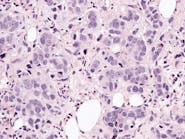A new study of advanced small-cell lung cancer (SCLC) led by researchers at The Ohio State University Comprehensive Cancer Center – Arthur G. James Cancer Hospital and Richard J. Solove Research Institute (OSUCCC – James) has identified molecular patterns linked to patients developing resistance to certain therapies, according to a news release from the university.
This study, published in the journal JTO Clinical and Research Reports, examined more than 60 tumors from five patients. OSUCCC – James researchers identified distinct mutational and molecular changes in four SCLC subtypes. The findings provide new insights into the patterns' treatment resistance and could offer new targets for the development of more effective immunotherapy and other therapies for advanced SCLC, which progresses quickly and is usually fatal.
SCLC accounts for up to 15% of lung cancer cases worldwide. The disease often responds well to chemotherapy when first diagnosed but then recurs in a lethal, treatment-resistant form.
For this study, the researchers analyzed genomic DNA and total mRNA from tumor cells removed from five deceased patients with advanced SCLC, along with circulating tumor DNA. The tissue was obtained as part of a rapid research autopsy study, originally supported by a Pelotonia Idea Grant. Tissue was collected within 16 hours of each patient’s passing, minimizing the molecular changes that occur in cells after death.
The five patients consented to undergo a research autopsy soon after death to allow the researchers to collect and evaluate many tumors. The researchers used sequencing technologies to identify genetic and molecular changes in four SCLC tumor subtypes. Many of the changes are associated with resistance to immune therapy and other treatments.
Key findings include:
· Feasibility for rapid research autopsy to provide in-depth insights into resistant lung cancers.
· Evidence that tumors continue to evolve after patients receive treatment. Even a single patient may have six to eight genetically distinct subtypes of their cancer — which could have implications for future drug development.
· The most common neuroendocrine SCLC subtypes showed high expression of the enzyme ARG2, a possible suppressor of immune responses.
· Support for the known association between the Wnt pathway and chemoresistance in advanced SCLC.





